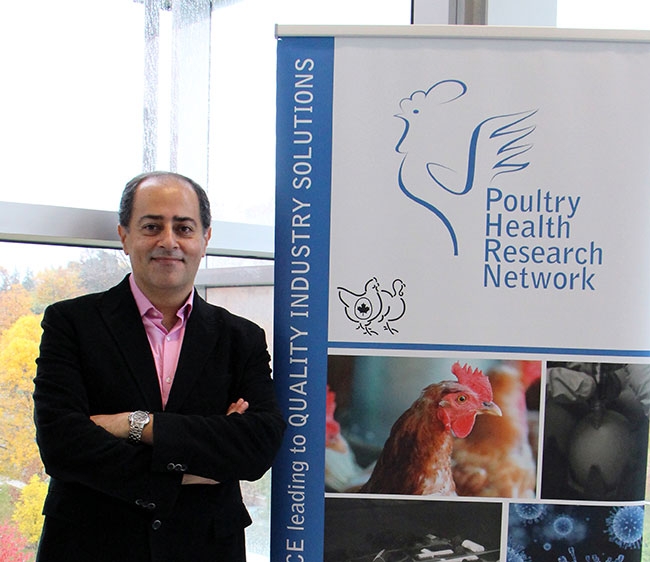
Research to advance poultry health
By Lilian Schaer
Features Health Research annex Antimicrobial use Canada Diseases Livestock medication Nutrition Ontario Poultry vaccinesResearch to advance poultry health
 Dr. Shayan Sharif, professor of poultry immunology at the University of Guelph and chair of the Department of Pathobiology at Ontario Veterinary College. PHOTO CREDIT: LRIC
Dr. Shayan Sharif, professor of poultry immunology at the University of Guelph and chair of the Department of Pathobiology at Ontario Veterinary College. PHOTO CREDIT: LRICA University of Guelph professor of poultry immunology is preparing to launch a new initiative devoted to reducing antimicrobial use in poultry through gut health.
Dr. Shayan Sharif, newly appointed chair of the Department of Pathobiology at Ontario Veterinary College, has brought together a national consortium of researchers from Western Canada, Ontario, Quebec and the Maritimes. Their goal is to collaboratively address various aspects of the poultry gut health question.
“What we are trying to do is create better solutions to enhance poultry health, and more specifically gut health, as a way of reducing the use of antimicrobials in poultry production,” Sharif explains. “This is a complex issue that requires a complex solution.”
Human health pathogens like Salmonella and Campylobacter are of interest to researchers, but there is also a particular focus on Clostridium perfringens. It’s the pathogen that causes necrotic enteritis, which, according to Sharif, could become more prevalent in the future as antimicrobial use for disease prevention is phased out.
“There are not a lot of solutions right now; we are moving towards a multi-pronged approach for control with made-in-Canada solutions that are cost beneficial and meet specific needs of Canada’s poultry industry,” he says.
Sharif is also currently leading a program focused on avian influenza (AI) control. Involving scientists from the Departments of Population Medicine, Computer Science, and Food and Resource Economics, the research is looking at new vaccine creation, disease spread modelling and evaluating the economics of various control strategies.
Computer scientists, for example, are turning to social media data mining for clues on when and where AI might emerge next. They are trying to establish a correlation between what is talked about by social media users and actual surveillance and diagnostic activities by bodies like the World Health Organization, the World Organization for Animal Health and others to help authorities with response and policymaking.
Sharif says the Canadian Food Inspection Agency, for example, does not distinguish between exposed and vaccinated birds, which can create problems with international trading partners. And traditional vaccines take 10-to-14 days to take effect – a long time in an outbreak situation – so the AI network is looking at alternatives that can create immunity in a flock in only a matter of hours and without impacting global trade.
At the same time, new delivery mechanisms are being developed for these alternative compounds so they can be administered to a large number of birds quickly and effectively. One solution in the works is encapsulating them in nanoparticles and using them in aerosols.
“This virus will emerge again in the future no matter what we do, so we had better be ready for it,” Sharif believes. “We are creating a decision support system for policy makers that can help them refine their strategies for control of the virus.”
Work in the AI network is funded by Canadian Poultry Research Council, Agriculture and Agri-Food Canada poultry cluster, Ontario Ministry of Agriculture, Food and Rural Affairs, Chicken Farmers of Saskatchewan, Egg Farmers of Canada and the University of Guelph’s Food from Thought initiative.
This article is provided by Livestock Research Innovation Corporation as part of LRIC’s ongoing efforts to report on Canadian livestock research developments and outcomes.
Lilian Schaer is a freelance writer and editor and communications specialist with Agri-Food Project Services Ltd. in Guelph, Ont.
Print this page